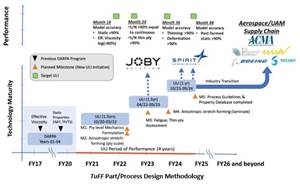Safran and Albany inaugurate new LEAP engine fan blade plant
The Mexico facility is the two companies’ third joint manufacturing plant to make composite parts for the LEAP aircraft engine.
Safran and Albany inaugurated Feb. 21, in Querétaro, Mexico, a third joint manufacturing plant to make composite parts for the LEAP aircraft engine. The inauguration ceremony was attended by Francisco Domínguez Servién, Governor of the State of Querétaro, Gerardo Ruiz Esparza, Mexico's Minister of Communications and Transport, Philippe Petitcolin, CEO of Safran, Olivier Andriès, CEO of Safran Aircraft Engines, and Joseph Morone, president and CEO of Albany International Corp.
This third joint plant is similar to and complements the two existing plants in Rochester, NH, US, and Commercy (eastern France), inaugurated in 2014. It involved a total investment of about US$100 million and delivered its first parts in October 2017, primarily making 3D woven composite fan blades for the LEAP engine from CFM International. As the LEAP program develops, the plant plans to also make guide vanes. The investment needed to add this capability will start this year, with delivery of the first parts expected in January 2019.
The new joint Safran/Albany plant in Mexico currently has nearly 230 employees, operating in a facility with 31,000 square meters (334,800 sq ft) of floorspace. The total workforce is expected to reach nearly 600 by 2021, to handle annual production of more than 20,000 composite blades and 31,000 outlet guide vanes.
Located in the Querétaro Aerospace Park, this newest plant benefits from its proximity to other facilities, including Safran Aircraft Engines Mexico and Albany's Machine Clothing plant in Cautitlan. Safran and Albany have been working closely together for nearly 20 years. Through this high value-added partnership, they have developed the 3D RTM (resin transfer molding) process used to produce fan blades and cases for the LEAP engine. The use of 3D woven composites makes a significant contribution to the LEAP's performance, since it offers 15% lower fuel consumption and CO2 (carbon dioxide) emissions than previous-generation engines.
"Our selection of the city of Querétaro for this new plant was primarily based on the excellent results logged since the construction of our first plant at this location more than 10 years ago," says Philippe Petitcolin, CEO of Safran. "This location was also confirmed by the relationship of mutual trust we have developed with local authorities and our partner Albany, and our shared vision of the excellent potential for the development of a Mexican aerospace industry. The creation of jobs and associated training programs are at the heart of this project, which also clearly reflects Safran's proactive international development strategy."
"After building three plants together, Albany and Safran know what collaboration means and what partnership requires,” adds Joseph G. Morone, president and CEO of Albany, "And it is this spirit and culture of collaboration that is one of the most important reasons why this plant is right on schedule, and already successfully manufacturing advanced 3D RTM composite parts, and already contributing to the LEAP program."
The construction of the new Safran/Albany plant in Mexico was announced in 2016 to support the ramp-up in LEAP production, which should reach a peak rate of more than 2,000 engines per year in 2020. Having already recorded over 14,000 orders and commitments, the LEAP is the fastest-selling engine in the history of aviation. Today, more than 210 LEAP-1A and LEAP-1B-powered airplanes are deployed by 33 operators on five continents, and they have already logged over 610,000 flight-hours and nearly 300,000 cycles.
Related Content
Coriolis Composites installs AFP machine at Sabanci University
C1 robot contributes to technology development at the Integrated Manufacturing Technologies Research and Application Center (SU IMC) in Istanbul.
Read MoreUD’s Center for Composite Materials hosts NASA University Leadership Initiative
October meeting of industry, government and academic accentuates the University of Delaware’s study of research and technology barriers in UAM using its new class of composite materials, TuFF.
Read MoreSustainability has come to composites and it's here to stay
It might be tempting to think of sustainability as a buzzword, but there are structural changes taking place in the composites industry that signal its permanence.
Read MoreChemnitz University of Technology receives €6 million to expand research into "green" carbon fiber
Carbon LabFactory and InnoCarbEnergy project conduct R&D across entire value chain from raw materials through processes to structures and systems on a pilot line with technology demonstrators.
Read MoreRead Next
Composites end markets: Energy (2024)
Composites are used widely in oil/gas, wind and other renewable energy applications. Despite market challenges, growth potential and innovation for composites continue.
Read MoreFrom the CW Archives: The tale of the thermoplastic cryotank
In 2006, guest columnist Bob Hartunian related the story of his efforts two decades prior, while at McDonnell Douglas, to develop a thermoplastic composite crytank for hydrogen storage. He learned a lot of lessons.
Read MoreCW’s 2024 Top Shops survey offers new approach to benchmarking
Respondents that complete the survey by April 30, 2024, have the chance to be recognized as an honoree.
Read More
.png;width=70;height=70;mode=crop)

























